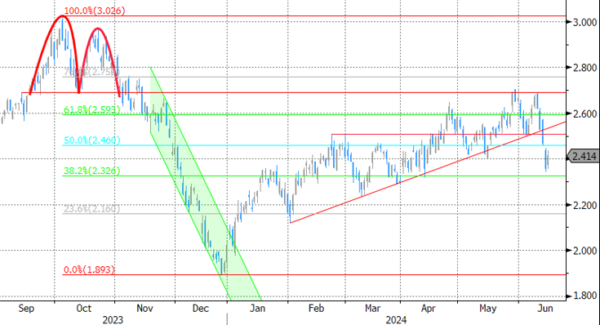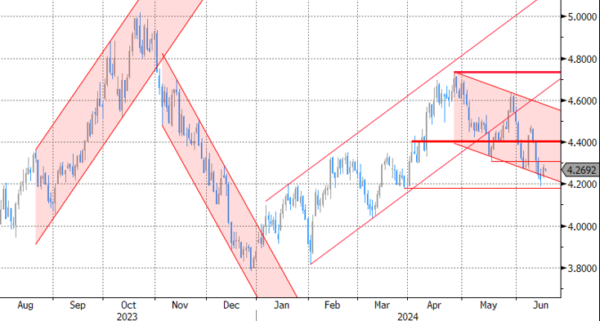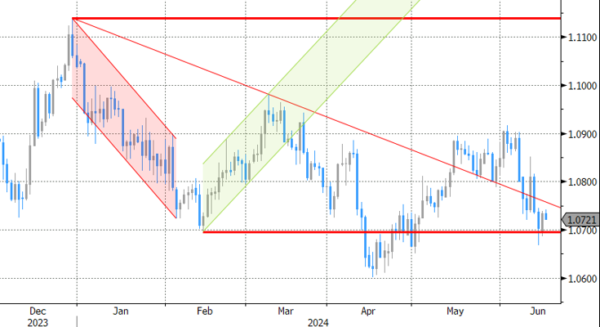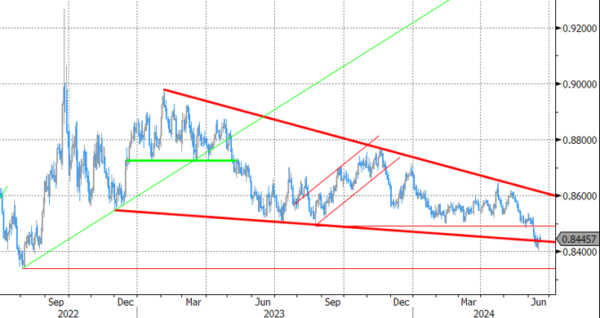Markets
The European risk-off from last week shifted into a lower gear. Markets pondered comments from Marine Le Pen of the far right Rassemblement National as she indicated she would respect France’s institutions and was prepared to cooperate with President Macron after the elections. Bunds returned part of their safe haven gains with yields rebounding 5-6 bps across the curve. Bund yields also rose more than swaps. The French 10-y yield spread vs Bunds still widened slightly further (+2 bps to 0.79%). Spreads of other South-European bonds (Italy, Spain, Portugal, Greece) that faced material collateral damage last week narrowed about 3-4 bps (vs Bunds). European equities (EuroStoxx 50 + 0.85%, CAC 40 + 0.91%) tried a bottoming out process after recent sell-off. ECB policymakers including Chief Economist Lane still labelled last week’s repositioning as orderly. The ECB currently has no intention to step in/activate the TPI mechanism. US yields which are still mainly driven by monetary policy considerations rather than by risk sentiment, also rebounded after last week’s soft May price data. A better than expected Empire Manufacturing survey helped US yields to cautiously move away from recent lows/key support levels. US yields rose 5.5-6.5 bps across the curve. In an outright disconnect from European markets, the S&P500 (+0.77%) and the Nasdaq (+ 0.95%) continued their record race. The dollar took a breather (DXY 105.32 from 105.51) but shows resilience despite a more constructive risk sentiment overall. EUR/USD closed at 1.0734 from 1.07 at the open. Still, the picture looks fragile. EUR/GBP also tries to move away from the 0.84 support area (close 0.845) as markets prepare for tomorrow’s UK CPI data and Thursday’s Bank of England policy decision.
This morning, Asian equities join the constructive sentiment on WS yesterday, mostly rising 0.5%-1.0%. Dollar gains marginally (EUR/USD 1.072, DXY 105.45). Later today, US May retail sales are scheduled for release. After a poor showing in April (0.0% M/M headline) markets look out whether the US consumer is able to keep growth afloat (headline 0.2% expected, control group +0.4%). After last week’s softer than expected price data (CPI, PPI and import prices) markets already frontloaded more easing, both for this and next year, than what the Fed is guiding. Still we see an asymmetrical risk for yields to again test the downside in case of a poor outcome. In Europe, political uncertainty will continue to linger. EUR/USD probably remains captured in a sell-on-upticks dynamics.
News & Views
Australia’s central bank left its policy rate unchanged at 4.35%. The pace of disinflation is slowing, but inflation still stays some way above the midpoint of the 2–3 per cent target range. The April CPI indicator rose by 3.6% y/y (up from 3.5% the month before) and core (ex. volatile items and holiday travel) by 4.1%. The May forecast assumed a return within the target in H2 2025 and to the midpoint in 2026. The economy remains in a state of excess demand and domestic cost pressures stay elevated. Labour market conditions eased but remain tighter than is consistent with full employment and inflation at target. The RBA concludes that while recent data have been mixed, they have been reinforcing the need to be vigilant for upside risks to inflation. The RBA ended the statement with the small yet meaningful addition that it will do what is necessary to achieve its goal. Board chair Bullock during the press conference later revealed they discussed the case for a rate hike. These hawkish tweaks pushed up Australian swap yields marginally intraday, allowing the curve to pare net daily declines to 0.5-1.9 bps with the long end outperforming. Money markets have changed little to their policy rate expectations and still pencil in a first cut in February next year. The Australian dollar trades basically unchanged just north of AUD/USD 0.66.
Germany’s electrical and metal workers union, the country’s largest industrial one, is upping the ante ahead of wage negotiations due to kick off this September. It is demanding a 7% increase for a 12-month period for the roughly 4 mln workers in a sector that’s a bellwether for wage agreements in other sectors. Given the industrial malaise in Germany and the fact that inflation was only 2.8% in May, the demand showcases ongoing efforts of union to recover some of the lost purchasing power over the previous years. It’s also closely watched by the ECB as it seeks signs for wage growth to slow down to help bringing back inflation sustainably to its 2% target.
Graphs
GE 10y yield
The ECB cut its key policy rates by 25 bps at the June policy meeting. A more bumpy inflation path in H2 2024, the EMU economy gradually regaining traction and the Fed’s higher for longer US strategy make follow-up moves difficult. Markets are coming to terms with that. For the time being, though, the political narrative dominates. After hitting a new YtD top at 2.7%, the German 10-yr yield corrected lower on safe haven bids.
US 10y yield
The Fed is seeking more evidence than just one slower-than-expected (May) CPI is providing. Upgraded inflation forecasts and a higher neutral rate complicate the exact timing of a first cut further. June dots suggest one move in 2024 followed by four more next year. Markets are positioned more aggressively, turning the recent low in yields into a technical support zone. The US 10-y yield is testing the downside of the 4.2/4.7% trading range.
EUR/USD
EUR/USD is trapped in the 1.06-1.09 range. The desynchronized rate cut cycle with the ECB exceptionally taking the lead, strong US May payrolls and a swing to the right in European elections pulled the pair away from 1.09 resistance. The Fed meeting balanced the weaker than expected US CPI outcome. Euro fragility makes a return to the 1.06 downside more likely than not.
EUR/GBP
Debate at the Bank of England is focused at the timing of rate cuts. Slower than expected April disinflation and a surprise general election on July 4 suggest that a June cut in line with the ECB looks improbable. Sterling gained momentum with money markets now discounting a Fed-like scenario. EUR/GBP tested the 2023 & 2024 lows near 0.85. Euro weakness eventually pulled the trick after French president Macron called snap elections following a weak showing in EU elections.
















